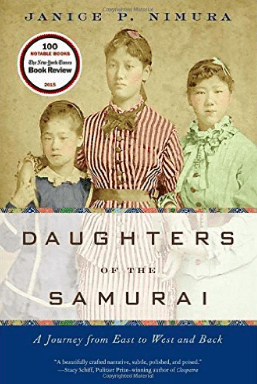Sutematsu Yamakawa Oyama was the first Japanese woman to earn a bachelor’s degree. Her remarkable feat occurred in the late 1800’s at Vassar College. Sutematsu was part of a Japanese experiment that is engagingly recounted in Daughters of the Samurai by Janice P. Nimura.
After Admiral Perry’s show of force in Japan’s Edo Bay, as the era of the samurai is ending, five young girls are selected to come to the United States. Their mission is to learn American culture and return to Japan to help the isolated Japanese kingdom progress to a culture that will have credibility in the “civilized” world.
Three of the girls, Sutematsu among them, remain in the United States for ten years. What they learn is to be curious, well-bred, and independent. What Japan wants is women who can teach other Japanese women to be “cultured,” but only as intelligent partners for their husbands and role models for their children. Japanese men do not see women as independent of the family. All three of the girls struggle with the conflict between their acculturation into American ideas and the reality of Japanese culture.
In Japan the three take different paths. One, Ume Tsuda, remains unmarried, an unusual situation in Japanese culture and eventually establishes a school where English is taught as she wishes, rather than as the Japanese culture had dictated. Another, Shige Nagai Uriu, teaches the music she learned in America, marrying and struggling to balance her work life with her career.
Sutematsu marries well, to a man who becomes general of the Imperial Japanese Army. At first it appears that, in spite of the fact that she does not read or write Japanese well, she has succumbed to Japanese culture and is filling her designated role in Japanese society. However, Sutematsu quietly goes about acculturating Japanese women to Western ways, teaching them about philanthropy and public service. She also raises funds for her friend’s English school and assures that the Empress knows of their success.
Daughters of the Samurai is beautifully written. The author pulls you into the scenes with her meticulous descriptions. She uses letters written by the girls and their correspondents, but never makes the reader feel as if she is merely quoting; the quotations flow naturally from her storytelling. I highly recommend this book.

